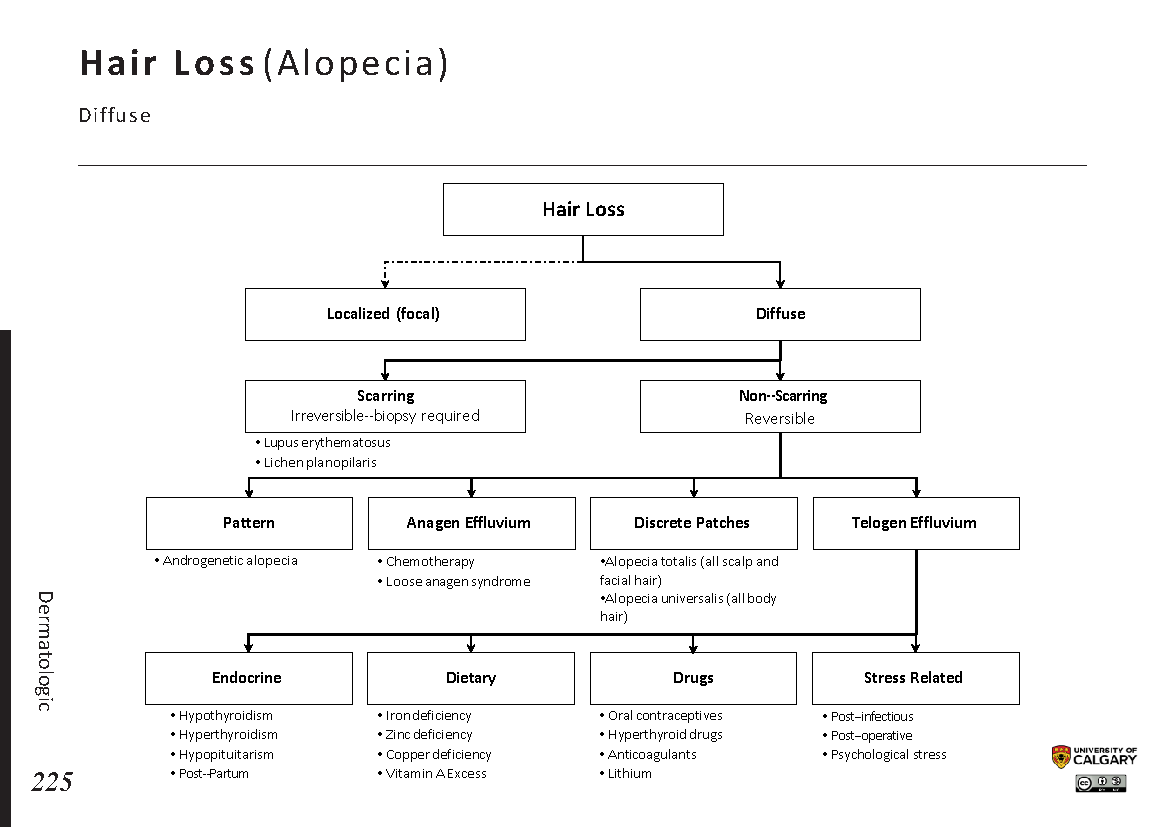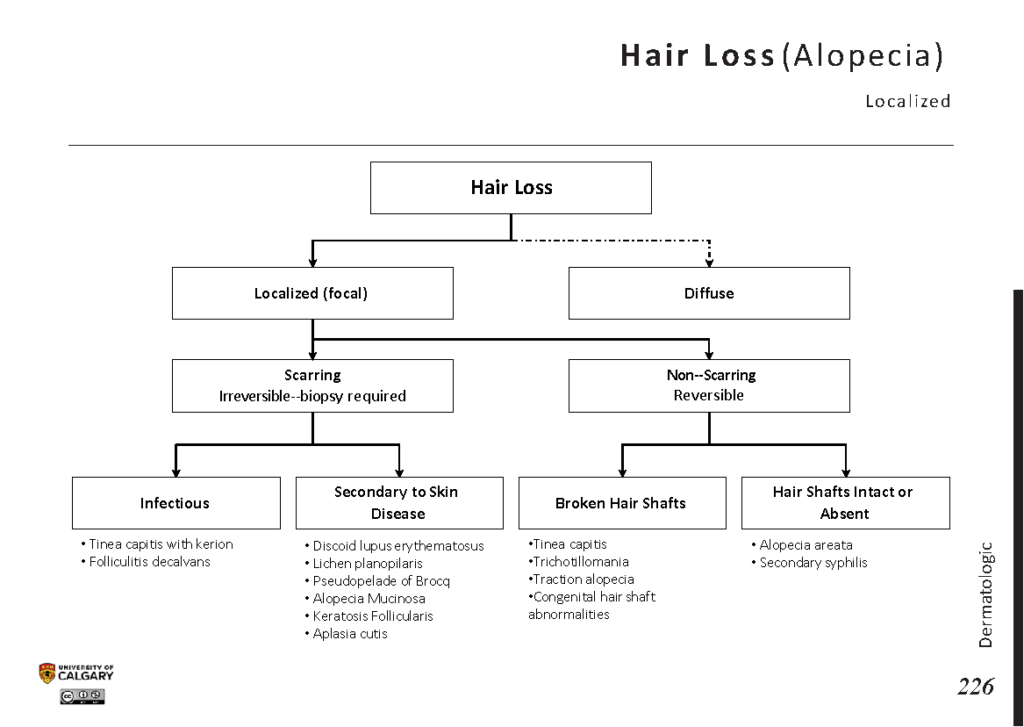Hair loss, medically referred to as alopecia, is a condition that affects millions of people worldwide. It can occur for various reasons, ranging from genetics to environmental factors, and it impacts both men and women. While some forms of hair loss are temporary, others may be permanent. Understanding the different types of alopecia, their causes, available treatments, and preventive measures is essential for managing this condition effectively.

Understanding Hair Loss
Hair loss refers to the shedding or thinning of hair on the scalp or other parts of the body. It is a natural process for individuals to lose between 50 and 100 hairs daily due to the hair growth cycle. However, excessive shedding or noticeable thinning can indicate an underlying issue. Hair loss can affect self-esteem and emotional well-being, making it a significant concern for many.
The Hair Growth Cycle
- Anagen Phase: This is the active growth phase where hair follicles produce new hair. It lasts for several years.
- Catagen Phase: A transitional phase where hair growth slows down. It lasts for about two to three weeks.
- Telogen Phase: The resting phase where hair stops growing and eventually sheds. It lasts for about three months.
Disruptions in this cycle can lead to hair loss. Understanding the specific type of alopecia is crucial for determining the appropriate treatment.
Types of Hair Loss
Androgenetic Alopecia
Androgenetic alopecia, commonly known as male-pattern baldness or female-pattern baldness, is the most common type of hair loss. It is influenced by genetic factors and hormones. In men, it typically results in a receding hairline and thinning at the crown. Women often experience diffuse thinning across the scalp without losing their frontal hairline.
Alopecia Areata
Alopecia areata is an autoimmune condition where the immune system mistakenly attacks hair follicles, leading to patchy hair loss. It can affect the scalp, eyebrows, eyelashes, or other areas of the body. In severe cases, it may progress to alopecia totalis (loss of all scalp hair) or alopecia universalis (loss of all body hair).
Telogen Effluvium
Telogen effluvium occurs when a significant number of hair follicles enter the resting phase prematurely, causing increased shedding. This condition is often triggered by stress, illness, surgery, or hormonal changes. Unlike other forms of hair loss, telogen effluvium is usually temporary.
Anagen Effluvium
Anagen effluvium is characterized by sudden and widespread hair loss during the active growth phase. It is often caused by chemotherapy, radiation therapy, or exposure to toxic chemicals. While the hair loss is dramatic, it is typically reversible once the underlying cause is addressed.
Traction Alopecia
Traction alopecia results from prolonged tension on the hair follicles, often due to tight hairstyles such as braids, ponytails, or extensions. Over time, this constant pulling can damage the follicles and lead to permanent hair loss if not corrected.
Trichotillomania
Trichotillomania is a psychological disorder characterized by compulsive hair pulling. Individuals with this condition may pull out their hair from the scalp, eyebrows, or other areas, leading to noticeable bald patches.
Causes of Hair Loss
Genetics
Genetic predisposition plays a significant role in androgenetic alopecia. If one or both parents experience hair loss, their children are more likely to develop the condition. Genetic factors influence how sensitive hair follicles are to dihydrotestosterone, a hormone that contributes to hair thinning.
Hormonal Changes
Hormonal imbalances can trigger hair loss. For example, pregnancy, childbirth, and menopause can cause temporary shedding due to fluctuating estrogen levels. Thyroid disorders, such as hypothyroidism or hyperthyroidism, can also disrupt the hair growth cycle.
Medical Conditions
Certain medical conditions, such as alopecia areata, lupus, and scalp infections, can lead to hair loss. Chronic illnesses, including diabetes and iron-deficiency anemia, may also contribute to thinning hair.
Medications and Treatments
Some medications, particularly those used to treat cancer, arthritis, depression, and high blood pressure, can cause hair loss as a side effect. Radiation therapy and chemotherapy are well-known culprits of anagen effluvium.
Nutritional Deficiencies
Inadequate intake of essential nutrients, such as iron, zinc, protein, and vitamins, can weaken hair follicles and lead to shedding. Crash diets or eating disorders may exacerbate this issue.
Stress and Trauma
Physical or emotional stress can disrupt the hair growth cycle, resulting in telogen effluvium. Major life events, such as the death of a loved one, divorce, or financial difficulties, may trigger this type of hair loss.
Treatments for Hair Loss
Medications
Several medications are available to treat hair loss, depending on the underlying cause. Minoxidil, commonly sold under the brand name Rogaine, is a topical treatment that promotes hair growth by extending the anagen phase. Finasteride, marketed as Propecia, is an oral medication that reduces dihydrotestosterone levels and is effective for androgenetic alopecia.
Laser Therapy
Low-level laser therapy uses red light wavelengths to stimulate hair follicles and improve blood circulation in the scalp. This non-invasive treatment has shown promising results for individuals with androgenetic alopecia.
Hair Transplant Surgery
Hair transplant surgery involves removing healthy hair follicles from donor areas, typically the back or sides of the scalp, and implanting them into balding regions. This procedure is suitable for individuals with stable hair loss patterns and sufficient donor hair.
Platelet-Rich Plasma Therapy
Platelet-rich plasma therapy involves extracting a small amount of the patient’s blood, processing it to concentrate platelets, and injecting it into the scalp. The growth factors in platelets promote hair regrowth and improve follicle health.
Scalp Treatments
Topical treatments, such as corticosteroids, can reduce inflammation and suppress the immune response in cases of alopecia areata. Other options include anthralin, a tar-like substance that stimulates hair growth, and topical immunotherapy, which induces an allergic reaction to trigger regrowth.
Prevention of Hair Loss
Maintain a Healthy Diet
Eating a balanced diet rich in vitamins, minerals, and proteins supports overall hair health. Foods high in omega-3 fatty acids, biotin, and antioxidants can strengthen hair follicles and prevent breakage.
Manage Stress
Practicing stress-reducing techniques, such as meditation, yoga, or deep breathing exercises, can help minimize the risk of stress-related hair loss. Seeking professional counseling for chronic stress or anxiety is also beneficial.
Avoid Harsh Hairstyles
Minimizing tension on the hair by avoiding tight hairstyles can prevent traction alopecia. Opt for loose braids, buns, or ponytails, and limit the use of heat styling tools and chemical treatments.
Regular Scalp Care
Keeping the scalp clean and moisturized promotes a healthy environment for hair growth. Regular washing with a mild shampoo removes excess oil and debris, while scalp massages improve blood circulation.
Monitor Health Conditions
Addressing underlying medical conditions, such as thyroid disorders or nutritional deficiencies, can prevent hair loss. Regular check-ups with a healthcare provider ensure early detection and management of potential issues.
Limit Exposure to Toxins
Avoiding exposure to harmful chemicals, pollutants, and smoking can protect hair follicles from damage. Wearing a hat or using sunscreen on the scalp during prolonged sun exposure is also advisable.
Conclusion
Hair loss is a multifaceted condition with various types, causes, and treatment options. By understanding the underlying factors contributing to alopecia, individuals can take proactive steps to manage and prevent further hair loss. Consulting with a dermatologist or healthcare professional is essential for developing a personalized approach to address this common yet complex issue.





